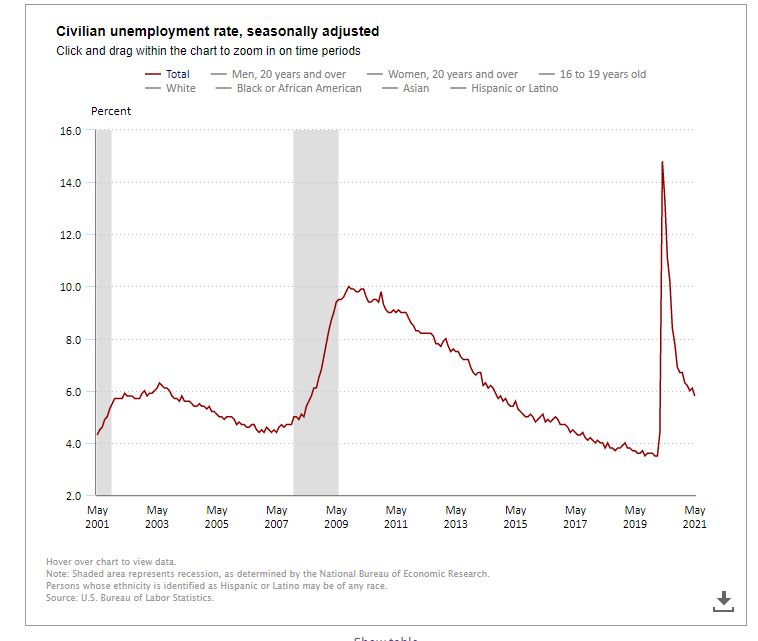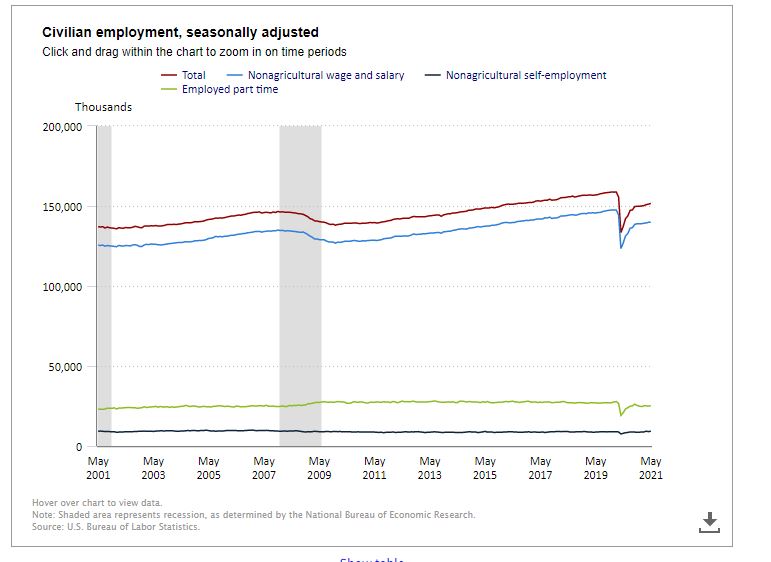Employment Blog June 2021
This employment blog is taken from the U S Department of Labor, Bureau of Labor Statistics. Total nonfarm payroll employment rose by 559,000 in May, and the unemployment rate declined by 0.3 percentage point to 5.8 percent. Notable job gains occurred in leisure and hospitality, in public and private education, and in health care and social assistance. Substantial job losses related to the coronavirus (COVID-19) pandemic first occurred in March (-1.7 million) and April (-20.7 million) of 2020. As economic activity resumed, employment increased by 12.6 million from May through November but declined again in December (-306,000) following a surge in the number of coronavirus cases. Job growth restarted in January of this year, and nonfarm payroll employment has increased by 2.4 million over the past 5 months. However, payroll employment is down by 7.6 million, or 5.0 percent, from the pre-pandemic employment peak in February 2020.


Employment in leisure and hospitality rose by 292,000 in May, as pandemic-related restrictions continued to ease in some parts of the country. The industry has added 1.3 million jobs since January. Employment rose in food services and drinking places (+186,000); amusements, gambling, and recreation (+58,000); and accommodation (+35,000). Employment in leisure and hospitality is down by 2.5 million, or 15.0 percent, since February 2020.
In May, employment increased in local government education (+53,000), state government education (+50,000), and private education (+41,000), reflecting the continued resumption of in-person learning and other school-related activities in some parts of the country. However, since February 2020, employment is down in local government education (-556,000), state government education (-244,000), and private education (-293,000).
Health care and social assistance added 46,000 jobs in May. Employment in social assistance increased by 23,000, with most of the gain in child day care services (+18,000). Social assistance employment is 257,000 lower than in February 2020. Employment in health care continued to trend up in May (+23,000), with a gain in ambulatory health care services (+22,000). Health care employment is 508,000 below the February 2020 level.
In May, employment in information rose by 29,000, with about half of the gain occurring in motion picture and sound recording industries (+14,000). Since February 2020, employment in information is down by 193,000.
Manufacturing employment increased by 23,000 in May, following a decline in the previous month (-32,000). The employment changes over the 2 months occurred primarily in motor vehicles and parts, which added 25,000 jobs in May, partially reversing a decrease in the previous month (-38,000). Overall, manufacturing employment is 509,000 lower than in February 2020.
Transportation and warehousing added 23,000 jobs in May, with employment gains in support activities for transportation (+10,000) and air transportation (+9,000). Since February 2020, employment in transportation and warehousing is down by 100,000.
In May, wholesale trade employment rose by 20,000, with most of the gain in the durable goods component (+14,000). Employment in wholesale trade is down by 211,000 since February 2020.
Construction employment edged down by 20,000 in May. Within the industry, nonresidential specialty trade contractors lost jobs over the month (-17,000). Employment in construction is 225,000 lower than in February 2020.
Employment in professional and business services changed little in May (+35,000). Within the industry, employment continued to trend up in accounting and bookkeeping services
(+14,000). Employment in temporary help services was little changed in May (+4,000), following a large decline in the previous month (-116,000). Overall, employment in professional and business services is down by 708,000 since February 2020.
Employment in retail trade changed little in May (-6,000). Food and beverage stores (-26,000) and health and personal care stores (-7,000) lost jobs, while clothing and clothing accessories stores (+11,000) and miscellaneous store retailers (+6,000) added jobs. Retail trade employment is 411,000 below the February 2020 level.
Employment in other major industries–including mining, financial activities, and other services–showed little change over the month.
Real average hourly earnings for all employees decreased 0.2 percent from April to May, seasonally adjusted, the U.S. Bureau of Labor Statistics reported today. This result stems from an increase of 0.5 percent in average hourly earnings combined with an increase of 0.6 percent in the Consumer Price
